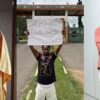
Loren Yuehan Wang ’25 is one of four student-curators whose projects about the history of student artistic practice at Wesleyan, “SUM OF ITS PARTS,” are on display in the Class of 1928 Vitrines, located on the first floor of the Library through April 21. And Wang’s mixed media artwork is on display in the exhibition “Exploding and Netting: A Somatic Archive of Transpacific Movement” in the College of East Asian Studies Gallery at Mansfield Freeman Center through May 25.
“These two feel quite connected,” Wang said of their work in the two archives. “It’s a new possibility for the future.”
A prolific young artist, Wang has more work for the Wesleyan community to enjoy. Their current work in “Exploding and Netting” is a response to what they found in the art and archival collection. It includes combining a floor covered in 15 buckets of dirt, gathered from the shore of the Connecticut River, near the Portland brownstone quarries, placed below a video projection of Wang’s filmed travels, including oceanic travel and trips to railways in New York, Utah, New Mexico, and California.
“It’s lots of physical labor,” they said of digging then transporting the dirt in their car over the course of four days. Other videos in the exhibition include Wang’s friends reading documents from the archives while Wang falls asleep on their bed.
An Artistic Collaboration
Wang’s works in the exhibition were curated by Xiran Tan ’24 and Yijing Lai ’24 as part of a tutorial in curatorial practice led by Exhibitions Manager Rosemary Lennox and Associate Director of Visual Arts Benjamin Chaffee ’00. Tan and Lai put together their exhibition proposal in September 2023, and initially approached Wang in October 2023 about creating works for the exhibition around immigration, the history and memory of the University, and what is truth and what is fiction.
Tan wanted to explore the hidden history at Wesleyan. She found gaps in the archives, and that many of the documents are not authored by people from China. “We wanted to represent a perspective from the Chinese international students,” Tan said. She said that Wang’s artwork touches on a lot of topics like intimacy, belonging, and migration that may not be documented as much in archival collections because it’s such a personal experience. “I think having that public exhibition to showcase an intimate understanding of a transnational Chinese perspective or experience is really valuable,” Tan said.
Lai said that collaboration was essential to their exploration. “Curation is definitely something I keep thinking about,” Lai said about her possible graduate studies in the future.
Chaffee and Lennox guided the students through the process of making Wang’s first exhibition, giving them the structure and framework to develop their curatorial ideas, but also the space and room to do the work over the course of a semester. “I feel like that’s a really hard balance to keep,” Wang said.
“It’s the first time we’ve ever done it,” Lennox said of the tutorial. “It was a pilot experience and experiment.”
The “Exploding and Netting” exhibition brought up questions about the boundaries between curatorial and artistic work when performance and installation are involved. “They were pretty fluid in their project together,” Chaffee said, noting that watching the students go through the process was instructive for him. “There’s no clear roadmap for that.”
Wang said the exhibition is an invitation for visitors to think about their own community. “What can they do to reorganize their social structure or relational dynamics to reach more autonomous space, or a more inclusive and open engagement with people?” asked Wang. Wang will hold two film screenings and conversations about their work at their house on March 29 and May 2 at 4:30 p.m.
An Artistic Partnership with the Center for the Arts
At the same time last fall, Wang worked on developing the display “Tunnel Fever: Working in unclaimable dimensions” in consultation with the Director of the Center for the Arts Joshua Lubin-Levy ’06 and Dietrich Family Associate University Librarian for Unique Collections and University Archivist Amanda Nelson. Wang was a student in Lubin-Levy’s course DANC 212 “Composition Across the Arts: Theory and Practice of Interdisciplinary Curating.”
Lubin-Levy said that students developed projects that used the Center for the Arts’ past to imagine new futures for the arts at Wesleyan. “Loren was really interested in how they have seen the tunnels used by students as a space that is connected to the arts departments, but just slightly outside of them,” Lubin-Levy said about activities derived from students’ studies that couldn’t or wouldn’t happen during class time. Lubin-Levy said the educational focus was to have the students come up with their own ideas, and then engage their peers in a collaborative process of development.
Wang focused on existing archival content about the tunnels for “SUM OF ITS PARTS,” including a video work by Aidan Champeau ’23, documentation of the 2019 immersive theater experience “This Between Shadow” by Visiting Instructor Tom Pearson, a senior music project by Matthew Valades ’08, and a 1997 poem from The Wesleyan Argus about the tunnels by Tamar Wilner ’00.
Wang also included a poster for the December 2023 “Instrument—Body” performance in the tunnels by Visiting Assistant Professor of Music and cellist Ethan Philbrick and artist and performer Justin Wong. Wang took Philbrick’s seminar in 2023.
This post was originally published on this site be sure to check out more of their content








